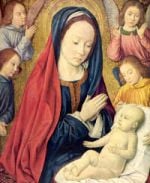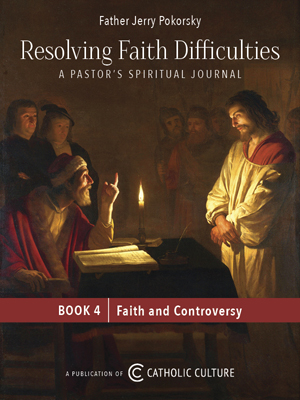Hope for all springs from the Cross of Christ
(Good Friday, 10 April 1998)
1. In the name of the Father and of the Son and of the Holy Spirit.
"God so loved the world that he gave his only Son" (cf Jn 3:16). For the salvation of the world, the eternal Son of God, who in the womb of the Virgin Mary assumed our human nature by the power of the Holy Spirit, became "obedient to the Father unto death, even the death of the Cross" (cf. Phil 2:8). Every day the Church ponders the supreme mystery of the saving Incarnation and the redeeming death of the Son of God, sacrificed for us on the Cross.
On this day, Good Friday, we pause to contemplate this mystery with still greater intensity. In the darkness of the late evening, we have come here, to the Colosseum, to follow once again, in the devotion of the Way of the Cross, the steps of Christ's journey of suffering, leading to the tragic climax of his death.
The spiritual ascent of Golgotha, where Jesus was crucified and surrendered his spirit, assumes a special significance among these ruins of Imperial Rome, particularly in this place linked to the death of so many Christian martyrs.
2. At this moment our mind goes back to everything recounte in the ancient Sacred History, where we find foreshadowings and foretellings of the Lord's death. How could we fail to evoke, for example, the journey of Abraham to Mount Moriah? We rightly recall this great Patriarch, whom Saint Paul calls the "father of all believers" (cf. Rom 4:11-12). It is he who receives the divine promises of the Old Covenant, and his life prefigures moments of the Passion of Jesus.
With his son Isaac, son of the promise, Abraham climbed Mount Moriah (cf. Gen 22:2), which looks symbolically to the mount on which the Son of Man would die on the Cross, to offer him in sacrifice. God had asked for the sacrifice of this only son, whom he had long awaited with unfailing hope. At the moment of sacrifice, Abraham himself becomes in a sense "obedient unto death" : the death of the son, and the spiritual death of the father.
This act, though it remained only a test of obedience and fidelity, since the angel of the Lord stayed the Patriarch's hand and did not allow Isaac to be killed (cf. Gen 22:12-13), is an eloquent foreshadowing of the definitive sacrifice of Jesus.
3. The Evangelist John writes: the eternal Father so loved the world that he gave his only Son (cf. Jn 3:16). The Apostle Paul echoes him: the Son became "for us obedient unto death, even death on the Cross" (cf. Phil 2:8). The angel did not stay the executioners' hand when the Son of God was sacrificed.
And yet in Gethsemane the Son had prayed that, if possible, the chalice of suffering might pass him by, though he immediately declared his complete readiness to do the Father's will (cf. Mt 26:39). Obedient for love of us, the Son offered himself in sacrifice, completing the work of redemption. Of this shocking mystery we are all witnesses today.
4. We stand silently on Golgotha. At the foot of the Cross is Mary, Mater dolorosa: this woman who is heartbroken with grief, but prepared to accept the death of her Son. The sorrowful Mother recognizes and accepts in the sacrifice of Jesus the Father's will for the redemption of the world. Of Mary the Second Vatican Council says: "The Blessed Virgin advanced in her pilgrimage of faith, and loyally persevered in her union with her Son unto the Cross. There she stood, in keeping with the divine plan (cf. Jn 19:25), suffering grievously with her only- begotten Son. There she united herself with a maternal heart to his sacrifice, and lovingly consented to the immolation of this Victim which she herself had brought forth. Finally, the same Christ Jesus, dying on the Cross, gave her as a mother to his disciple. Thus he did when he said: "Woman, behold your son" (Lumen Gentium, 58).
Mary was given as a mother to all of us, who are called to follow faithfully the steps of her Son who for us was made obedient unto death, death on a cross: "Christus factus est pro nobis oboediens usque ad mortem, mortem autem crucis" (Antiphon of Holy Week; cf. Phil 2:8).
4. It is now the dead of night. As we contemplate Christ dead on the Cross, our thoughts turn to the countless injustices and sufferings which prolong his passion in every part of the world. I think of the places where man is insulted and humiliated, downtrodden and exploited. In every person suffering from hatred and violence, or rejected by selfishness and indifference, Christ continues to suffer and die. On the faces of those who have been "defeated by life" there appear the features of the face of Christ dying on the Cross. Ave, Crux, spes unica! Today too, from the Cross there springs hope for all.
Men and women of our time, look upon the One who was pierced! Out of love he gave his life for us. Faithful and docile to the will of the Father, he is for us an example and an encouragement. Precisely by reason of this filial obedience, the Father "has highly exalted him and bestowed on him the name which is above every name" (Phil 2:9).
May every tongue proclaim "that Jesus Christ is Lord, to the glory of God the Father" (cf. ibid., 2:11
This item 334 digitally provided courtesy of CatholicCulture.org






